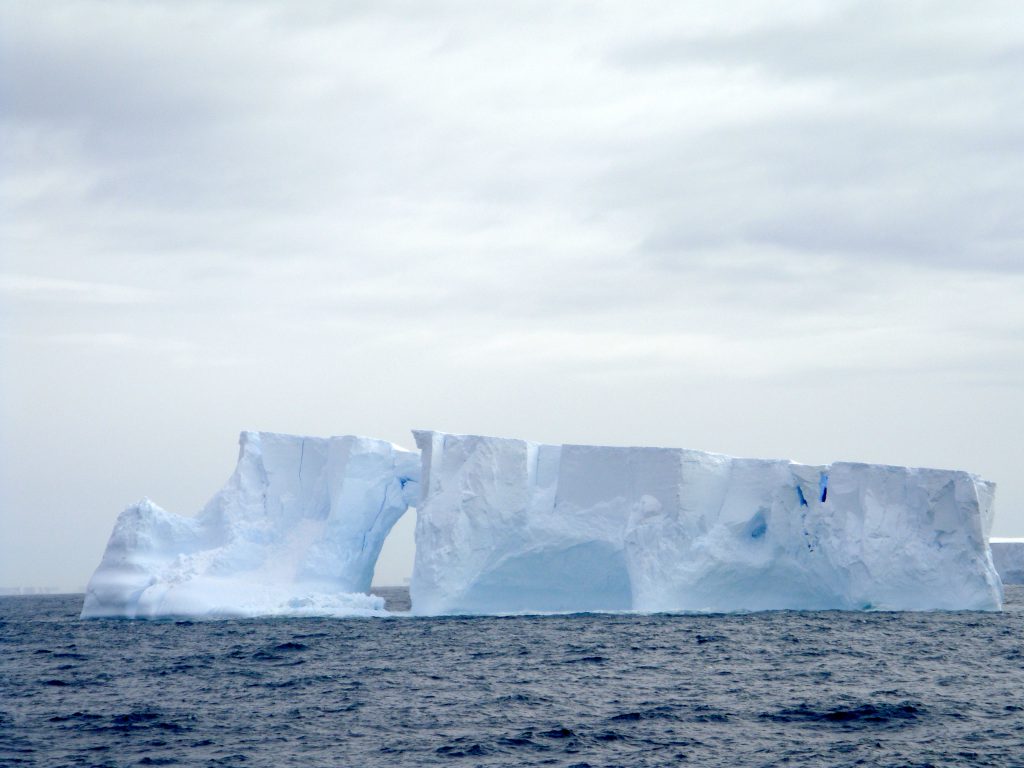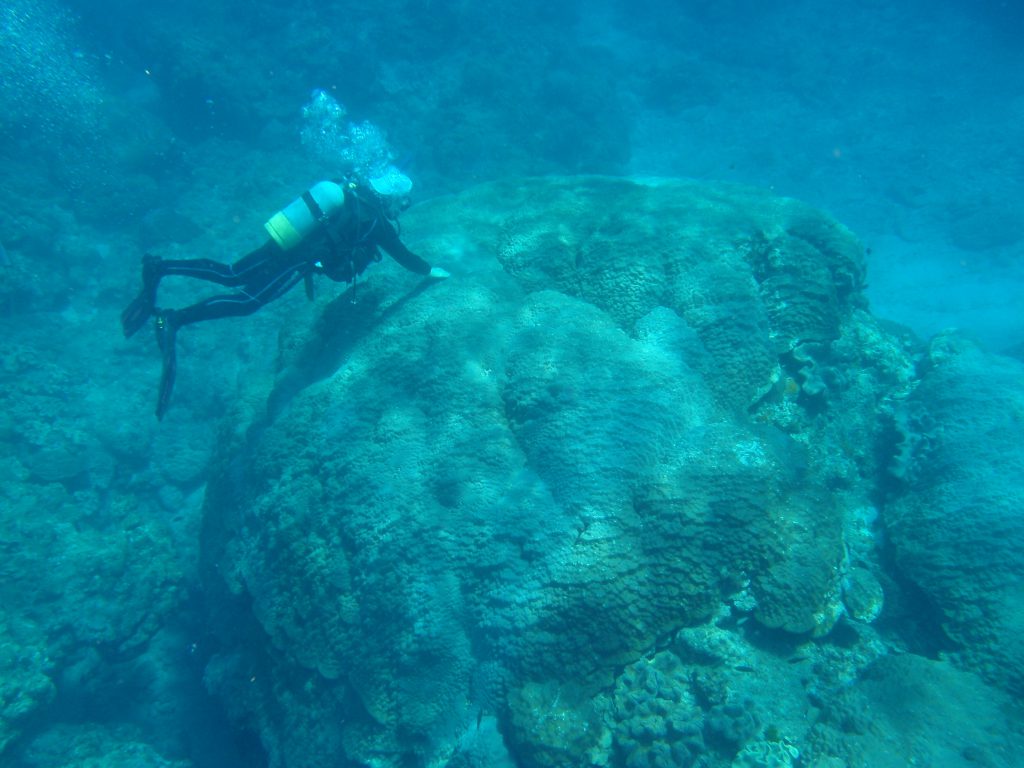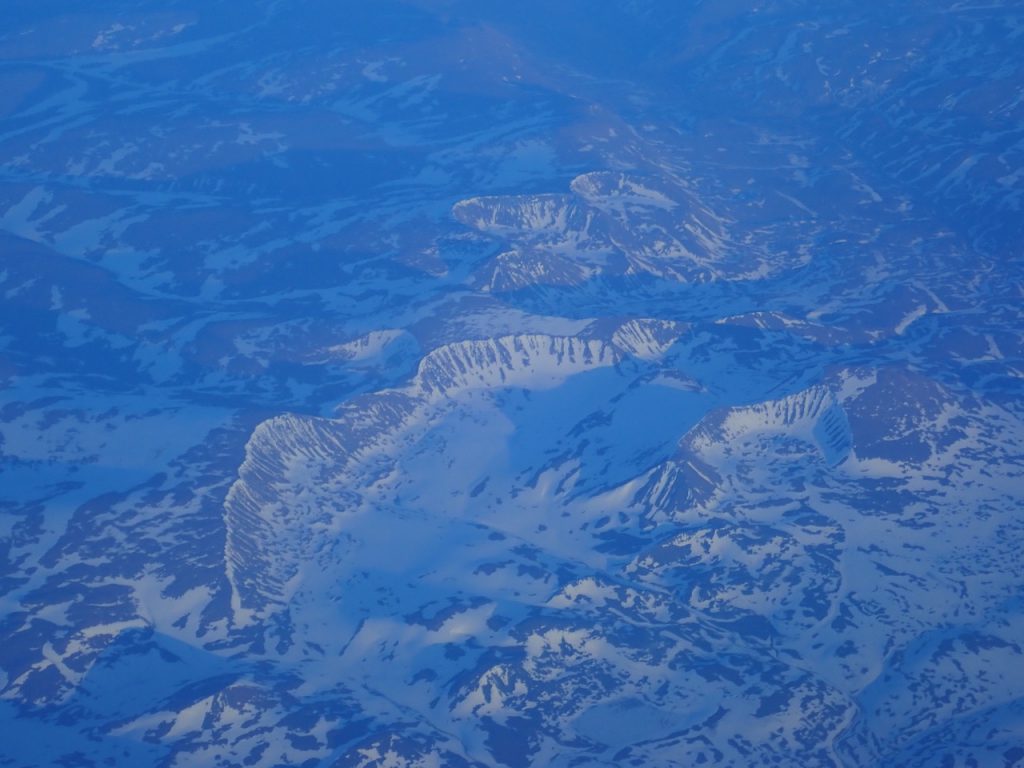Research
南極の環境変動

地球上の約70%の淡水を蓄えている南極氷床は、地球温暖化に伴い融解することで、海面上昇など、グローバルな気候変動を引き起こすことが危惧されています。今後の極域氷床の退氷を予想し、その気候変動への影響を知るためには、過去の氷床変動・プロセスを理解することが不可欠です。特に、南極氷床はボリュームが大きく重要ですが、その変動に関する長期データは圧倒的に不足しているのが現状です。南極氷床は安定なのか、氷床コア、岩石分析そして海洋堆積物を使い明らかにしようとしています。
岩石から氷床を探る ― 宇宙線照射生成核種による氷床消長の復元
近年開発された「表面照射年代法」は、地表面に露出している岩石の石英(SiO2)中に、宇宙線の作用で生成される「宇宙線照射生成核種」(10Be、26Alなどの極微量元素)の濃度から、地表面が宇宙線にさらされた期間 (露出年代) を直接求める手法です。岩石が宇宙線にさらされた期間が長いほど、宇宙線照射生成核種の濃度が高くなる、という関係になります。
この手法を用いると、南極の露岩域の露出年代(=氷床が融けて下の岩が露出した年代)を直接測定でき、過去の氷床変動を復元することができます。
私達は、国立極地研究所、広島大学などと共同で、東南極氷床の露岩域(上写真)で採取された岩石の10Be、26Alを、東京大学の加速器質量分析計(AMS)を用いて分析しました。そのデータから表面照射年代を求め、この地域で氷床が融けた時期を調べました。
これまでに水平方向の氷床変動のデータを得ており、今後さらに鉛直方向の変動を復元することで、三次元的な氷床変動の復元を目指しています。氷床の垂直方向の変動が復元可能な、氷床から露出している山の頂での表面照射年代データを求める予定です。
海底堆積物に記録された、南極氷床の融解史
南極海の堆積物は、氷床の融解史を、時系列順に詳細に記録していると考えられています。しかし、古海洋学で一般的に用いられる「浮遊性有孔虫」が、南極海にはほとんど生息しておらず、従来の手法では南極海堆積物から十分な情報を取り出せませんでした。そこで私たちは、「有機物の化合物レベル同位体比測定」や「ケイ藻殻の酸素同位体比測定」など、新たな手法を用いて研究に取り組んでいます。
有機物の化合物レベル同位体比測定
南極のうち西南極氷床は、ほとんどが現在の海水準面以下の基盤岩に乗っています。つまり、海水にどっぷりと浸かった海洋氷床です。その地球温暖化に対する応答は明らかにされておらず、氷期から間氷期へ至る温暖化時の動態についても、ほとんど分かっていません。その最大の原因は、西南極氷床周辺域における海底堆積物が、南極大陸で削剥され運ばれてきた大量の陸源物質に薄められ、過去の環境シグナルがノイズに埋もれてしまっているからです。
私たちは、海洋研究開発機構や国立極地研究所、米ライス大学などと共同で、海洋のプランクトンが生合成する有機物(バイオマーカー)の放射性炭素年代や水素同位体比を測定することで、ノイズの中からシグナルだけを抽出する手法の開発を行ってきました。
これまでに、水素同位体比の測定から、西南極氷床が最近1万年の間に4回融解したというデータが得られており、現在、氷床融解のタイミングを精密に年代決定する手法(化合物レベル放射性炭素測定)を開発しています。今後、さまざまな地点の堆積物コアで測定を行い、西南極氷床の融解プロセスについて総合的な考察を行います。
ケイ藻殻の酸素同位体比測定
準備中
氷床コア
準備中
中・低緯度の環境変動

赤道域、特に西赤道太平洋は、表層水の温度が高く、地球のヒートエンジンとしての役割を果たしています。この地域の変動によって引き起こされるENSO(エルニーニョ南方振動)やモンスーン変動などについて、サンゴ試料や海洋・湖沼堆積物そしてモデルを用いて研究しています。
サンゴ骨格の化学分析
サンゴはイソギンチャクなどと同じ刺胞動物ですが、外骨格として炭酸カルシウムの骨格を形成するのが特徴で、サンゴ礁を形成するサンゴは造礁サンゴと呼ばれます。この造礁サンゴは体内に褐虫藻が共生の形で多数存在し、サンゴはこの褐虫藻による光合成産物をエネルギーとして利用しています。
サンゴは海水中のカルシウムイオンと炭酸水素イオンを用いて炭酸カルシウムの骨格を作りますが、その際に海水の水温や塩分などの情報も骨格に取り込みます。この骨格は樹木のように季節による年輪が見られ、ハマサンゴ属のような塊状サンゴは骨格が1年に1~2cmほど成長し、中には直径3~5mまで成長するような大きな群体もあり、このようなサンゴ骨格には過去数百年間の海水の情報が記録されていると考えられます。化石のサンゴにも同様の情報が記録されているため、放射性炭素年代測定法などによってサンゴの生きていた時代を特定することで、例えば5000年前の海の水温や塩分を高時間分解能で復元することができます。
サンゴ骨格中の化学組成分析から、過去の海洋環境について様々な情報が得られます。例えば、サンゴ骨格中のストロンチウム/カルシウム比(Sr/Ca)からは、表層海水温が復元できます。酸素同位体比とSr/Ca比を組み合わせると、表層海水の塩分も復元できます。また、ホウ素同位体比を分析すると、海水のpHを復元することも可能です。
私たちは、主に過去2万年間の中低緯度における気候・海洋環境変動の解明を目指して、沖縄やフィリピン、タヒチなどのサンゴを採取し、様々な化学分析を行っています。復元された過去の海洋環境の情報から、モンスーンやエルニーニョといった気候システム変動について考察を進めています。
サンゴ組織の分子生物学的解析
Oceans are experiencing a rapid sea temperature change – about 0.53 degrees celcius/100 years according to IPCC. Skeletal element ratios of modern and fossil corals record sea temperature, thus they can provide long-term sea temperature data to Global climate models.
堆積物の化学分析
準備中
Chemical Analysis of Sediments
In preparation
古気候復元と大循環モデルの統合
2007年に発表されたIPCC第4次報告書では、気温上昇予測に関しては、異なる気候大循環モデルの予測が比較的一致した傾向が示されています。しかし一方で、水循環変動予測の高精度化が、将来の課題として挙げられています。さらに、古気候データとモデルとの綿密な比較による、モデルの動作特性の定量的評価が必要とされています。
水循環の変動は、温暖化に伴う干ばつや洪水の予測に重要です。特に東アジアから南アジア地域においては、世界の人口が多く集中し、モンスーン変動などに伴う水循環の変動によって生活環境が大きく影響を受けます。これらの地域の環境政策に、水循環変動予測の高精度化は大きく貢献します。
そこで私たちは、海洋研究所、気候システム研究センター、海洋研究開発機構などと共同で、サンゴを採取・分析して古気候データを解析・復元する地球化学者と、モデルを扱う研究者で構成されるチームを組みました。サンゴ骨格分析による古気候復元データと、地球シミュレータを用いた気候変動モデル(MIROC)の計算結果とを比較することで、より定量的に水循環メカニズムの解明を行うことができます。
太陽活動と地球磁場変動


銀河宇宙線と大気との相互作用によって生成される核種(10Be、14C、26Al、36Clなど)は、過去の地球磁場変動と太陽活動の変化を記録しています。氷床コア、海底・湖沼堆積物、樹木年輪中のこうした極微量核種の分析を通して、これらの変動機構の解明について明らかにしようとしています。さらに、太陽活動に関しては、1%に満たない日射量の変化は気候変動にほとんど影響を及ばさないと考えられてきましたが、日射量ではなく銀河宇宙線の到達量の変動が気候と関連している事が、我々の研究から明らかになりつつあります。地球磁場と気候の関係もスタートさせています。
宇宙線生成核種による変動史復元
銀河宇宙線入射量は、太陽活動度と地磁気強度の関係から決まります。これは、太陽活動に由来する磁場・太陽プラズマと地磁気の双方が地球を覆い(左図)、銀河宇宙線の大気圏侵入をコントロールしていることに由来します。つまり、太陽活動が活発なほど、また地磁気強度が大きいほど銀河宇宙線の侵入が減ります。
宇宙線生成核種(10Be、14C、26Al、36Clなど)は、銀河宇宙線が大気上層の気体分子(窒素、酸素など)と反応することで生じる、極微量核種です。私たちは、海底堆積物コア(右写真)や湖底堆積物コア、氷床コア、樹木年輪などに含まれる宇宙線生成核種を、加速器質量分析計(AMS)を用いて分析することで、過去の太陽活動や地球磁場の変動を復元しています。
例えば、南極ドームふじの氷床コアや、水月湖の堆積物コアの10Be分析からは、約4万1千年前に地磁気が弱まったイベント「Laschampエクスカーション」が、10Beのピークとして明瞭に検出されました。南極氷床コアに関してはさらに、26Al、36Clも分析して、イベントを詳細に調べています。
また、樹木年輪の14Cや、氷床コア浅部の10Beの分析からは、「マウンダー極小期」(AD1645-1710)など太陽黒点が見られなかった期間の、特異的な太陽活動変動を、年スケールで調べています。最近では、約2万年前の最終氷期極相期(LGM)の太陽活動変動を、樹木年輪14Cから調べる研究をスタートさせました。
古地磁気記録と宇宙線生成核種を組み合わせて、地球磁場と太陽活動の変動を分離したり、古地磁気記録の特性を調べる研究も、スタートさせています。
銀河宇宙線と気候変動の関係
近年、太陽活動の変動と、地球における気候変動の関係が議論されています。太陽活動と気候変動が相関するメカニズムとして近年注目されているのが、銀河宇宙線入射量と雲量が関係しているというアイディアです。銀河宇宙線入射量には、太陽活動だけでなく地球磁場の変動も反映されるため、地球磁場が気候に影響してきた可能性も指摘されています。
私たちは、上記で紹介したような太陽活動・地球磁場変動の復元データと、当時の気候変動の復元データを比較することで、銀河宇宙線が気候に影響を与えうるのか、どのような関係性を持っているのか、調べています。
例えば、樹木年輪に関しては、酸素同位体比(d18O)の分析から、湿度や降水量といった気候データを週~年スケールで復元できます。私たちはこの手法を、北海道大学と共同で、上記で紹介したマウンダー極小期やLGMなどの樹木年輪に適用して、14Cによる太陽活動変動のデータと直接比較することで、両者の関係を探っています。
さらに、人工衛星による雲観測データの解析も行っており、銀河宇宙線が気候に影響するメカニズムの詳細を探っています。
固体地球の変化と表層環境変遷

氷期に存在した氷床は、厚さ3kmにもおよび表層環境に様々な影響をもたらしたと考えられます。その後、氷という巨大な“荷重”がとりさられることにより、地球は変形し海水準の変動などを引き起こしました。山脈の形成-気候との関係についての研究もスタートさせています。
マントルの粘性決定 ― 氷床の荷重で地球が変形
地球は粘弾性体であるため、長期的な荷重にはゆっくりと変形します。表層に展開した大きな荷重、例えば厚さが3kmもあるような巨大な氷床や、それが解け出して海洋に流れ込み、世界中の海水準を130mも上昇させるような海水などによって、いわばサッカーボールのように変形するのです。
そのような固体地球の変形を観測-解析することによって、マントルの粘性がどれくらいか推定することが可能です。特に過去13万年間の地殻均衡(アイソスタシー)による地殻変動を正確に見積もることにより、上部および下部マントルの粘性構造を決定することができるため、主にこの期間を研究しています。
今から2万年前と1万年前の北部オーストラリア。巨大氷床が北半球に存在していた為、世界の平均海水準が約130m低かったため、ここには巨大な湖が存在していた。
地球表層プロセス ― 気候変動が山脈形成のトリガー?
ここ10年間の分析化学の発達によって、地球表層に届く微弱な宇宙線と岩石鉱物中に含まれる元素との相互作用によって生成される放射性核種を測定することができるようになったことから、10Be, 26Al, 36Cl, 14C, 3He, 21Neなどの核種を使って、地球表層に残された過去のイベントを定量的に議論できるようになりました。
現在、太平洋の周りに広がる、テクトニックにアクティブな地域をフィールドワークを含んだ総合的な研究を行っています。 ここ数年力を入れて研究している地域は、南米チリのアタカマ砂漠です。
近年、南米・チリ・アタカマ砂漠とアンデス山脈地域において、アタカマ砂漠の乾燥化(気候変動)が、アンデス山脈の隆起(固体地球の変化)を引き起こした、という可能性が示唆されました。しかしながら、この因果関係を実証するような、乾燥開始のタイミングや発達過程に関する情報は、非常に少ないのが現状です。例えば乾燥化開始のタイミングは、約35-14 Maという非常に大まかな年代しか分かっていません。
私達は、アタカマ砂漠のうち、極度に乾燥した地域を対象として、宇宙線照射年代測定法(10Be、26Alの分析)を用いて、乾燥開始時期を精度良く決めようとしています。さらに、経度に沿って高密度に乾燥化発達過程を復元することで、「アタカマ砂漠地域の乾燥化が、アンデス山脈の隆起速度を加速させたかどうか」、「乾燥化の発達過程において、どの時期にアンデス山脈の隆起に影響を及ぼしたか」を明らかにしようとしています。
Climate Changes in Antarctica

Glaciers in Antarctica store 70% of the earth’s fresh water. Glacial melt due to the earth’s warming causes sea levels to rise. It is essential to understand the past glacial variability and the process to predict glacial melt in the future to determine how glacial melt influences climate. The glaciers in Antarctica are especially significant because of their high volume, however sufficient long term data does not exist. Thus, we are researching glacial stability in Antarctica by analyzing ice cores, rocks, and oceanic sediments.
Exploring Glaciers from Rocks: Reconstructing Glacial Retreat by Terrestrial Cosmogenic Nuclides
A newly developed method, cosmogenic exposure ages, measures the concentration of terrestrial cosmogenic nuclides, such as trace elements of 10Be and 26Al. This method directly predicts how long the earth’s surface has been exposed to cosmic rays. The correlation is: the longer the rocks are exposed to cosmic rays, the higher the concentration of cosmogenic nuclides is.
With this method, we can reconstruct glacial fluctuations, as it is feasible to measure the exposure age of ice free areas (age of rocks being exposed because of glacial melt) in the Antarctica.
We collaborate with the National Institute of Polar Research and Hiroshima University to analyze 10Be and 26Al in sampled rocks from the southeastern part of the ice free area (pictured above) by accelerator mass spectrometry at the University of Tokyo. With the data from this analysis, we estimated the cosmogenic exposure ages and investigated when the glacier melted in this area.
To date, we have gathered data about horizontal glacial fluctuations. Now our goal is to understand three-dimensional glacial fluctuations by studying vertical anomalies. We plan to sample the top of mountains that are exposed from glaciers to reconstruct vertical glacial fluctuations.
History of Glacial Retreats in Antarctica Recorded in Ocean Sediments
Ocean sediments in the Antarctic Ocean are known to record the history of glacial melt chronologically in detail. However, planktonic foraminifera, widely used in paleoceanography, rarely live in the Antarctic Ocean, so it was not feasible to reconstruct the past environment with this conventional method. We are applying innovative methods such as examining isotope ratios of organic compounds and oxygen isotope ratios in diatom shells.
Isotope Ratios in Organic Compounds
In Antarctica, most of the southwestern section of the glacier lies on bedrock that is below the current sea level – meaning it is completely submerged in seawater. Our current understanding limits the ability to predict how these submerged sections of glacier would respond to global warming or how they responded to the temperature increase from glacial to interglacial periods. The sediments around the southwestern section of the glacier have been mixed with a large quantity of materials from the continent obscuring a clear environmental signal.
We collaborated with the Japan Agency for Marine-Earth Science and Technology, the National Institute of Polar Research, and Rice University to develop a method to extract environmental signals by measuring radio carbon and hydrogen isotope ratios in organic compounds (biomarker) synthesized by oceanic planktons.
From the measurements of hydrogen isotopes, the data suggests the southwestern glacier has melted four times in the past 10,000 years. We are currently exploring a new method to analyze carbon isotopic ratios in organic compounds to identify the timing of glacial melts with a higher precision than previous methods. We also plan to analyze ocean sediments from multiple stations to gain more insight into the process of glacial melt in this area.
Climate Changes over Mid- and Low- Latitude

Equatorial regions, especially the western equatorial Pacific Ocean, have high surface water temperature. Thus they play a role in the heat engine for the earth. We research ENSO (El Niño Southern Oscillation) and monsoon variability caused by changes in this area using coral samples, ocean and lake sediments, and climate models.
Chemical Analysis of Coral Skeletons
Corals belong to the phylum Cnidaria that includes sea anemones and jellyfish. Corals create exoskeletons made from calcium carbonate, and those that create reefs are called hermatypic corals. These corals have many symbiotic Zooxanthellae and utilize their photosynthetic products as an energy source.
When corals create calcium carbonate skeletons using calcium and bicarbonate ions in sea water, they capture information such as sea temperature and salinity. In these skeletons, we can observe annual rings like tree rings. Hermatypic corals, such as Genus Porites, grow 1 to 2 cm per year. Some Porites grow 3 to 5 m in diameter, thus these coral skeletons are believed to record a few hundred years worth of seawater information. Fossils of coral also record this information allowing us to reconstruct past sea temperature and salinity from them as well. For example, a 5,000 years old sample can be accurately dated using carbon 14. Further analysis using other methods can reconstruct past sea temperature and salinity with a high resolution.
From coral skeletal analysis, we are able to obtain a variety of information about past oceanic environments. For example, we can reconstruct sea surface temperature from strontium/calcium ratios in coral skeletons. Also, analyzing isotope ratios of boron allows us to reconstruct past pH history.
We are aiming to elucidate the climate and oceanic environment changes mainly around mid- to low- latitude regions for the past 20,000 years. Thus, we have been conducting varied chemical analyses with corals from Okinawa, Philippines, Tahiti and others. From reconstructed information about the past oceanic environments, we investigate climate variability such as monsoons and El Niño.
Molecular-biological Analysis of Coral Skeletons
Oceans are experiencing a rapid sea temperature change – about 0.53 degrees celcius/100 years according to IPCC. Skeletal element ratios of modern and fossil corals record sea temperature, thus they can provide long-term sea temperature data to Global climate models.
Chemical analysis of marine sediments
In preparation
Combining the Reconstructed Paleoclimate Record and General Circulation Models.
According to the IPCC Fourth Assessment Report: Climate Change 2007, different general circulation models predicted similar trends of global temperature. On the other hand, the prediction of water cycle variability with a higher resolution is needed as a future mission. Moreover, the quantitative evaluation on model’s operating characteristics is required by the detailed comparison between paleoclimate data and models.
Water cycle variability is important to predict droughts and floods due to global warming. Especially in eastern to southern Asia, where most of the world’s population is concentrated, the environment can be largely affected by monsoon and water cycle variability. Thus, a prediction with higher precision for future water cycle will greatly contribute to the environmental management in these areas.
We collaborated with the Atmosphere and Ocean Research Institute, Center for Climate System Research, and Japan Agency for Marine-Earth Science and Technology to create a scientific team. The team is comprised of modelers who are specialized in climatology and geochemists who collect and analyze corals as well as reconstruct and interpret paleoclimate data. The comparison of calculation results between paleoclimate data based on coral skeletons and climate models using earth simulations (MIROC) can elucidate water cycle mechanisms quantitatively.
Solar Activity and Earth’s Magnetic Field Anomaly


Nuclear isotopes (10Be, 14C, 26Al, 36Cl, etc.), created by the interaction between cosmic rays and atmosphere, record the past solar activity and earth’s magnetic field anomaly. We are trying to reveal the system of this variability by analyzing rare nuclear isotopes in ice cores, ocean and lake sediments, and tree rings. Moreover, it was previously believed that the change in solar radiation by as little as 1% didn’t affect the climate variability. However, we’re now discovering that cosmic rays reaching the earth, not solar radiation, affect global climate. We are investigating the relationship between the earth’s magnetic field and climate as well.
Reconstructing Climate Variability using Cosmogenic Nuclides
Cosmic rays are subject to the relationship between the level of solar activity and the earth’s magnetic field. The higher the solar activity is or the stronger the earth magnetic field is the lower amount of cosmic rays intrude into the atmosphere.
Cosmogenic nuclides (10Be, 14C, 26Al, 36C, etc.) are extremely rare isotopes produced by the reaction between cosmic rays and gas molecules (N, O, etc.) in the top layer of earth’s atmosphere. We analyze cosmogenic nuclides in ocean and lake sediments, ice cores, and tree rings by accelerated mass spectrometry to reconstruct the past solar activity and earth’s magnetic field variability.
For example, the high peak of 10Be in the ice core from Dome Fuji in Antarctica and the lake sediment from Lake Suigetsu revealed that earth’s magnetic field weakened 41,000 years ago (Laschamp excursion). We are analyzing 26Al and 36Cl in the ice cores from Antarctica, to investigate further details about this event.
Also, from the analysis of 14C in tree rings and 10Be in shallow Antarctic ice cores, we are researching specific solar activities with yearly resolution, such as Maunder minimum (AD1645-1710), a period when solar black spots were not observed. Recently, by analyzing 14C in tree rings, we started investigating the solar activity anomaly during the last glacial maximum (LGM), about 20,000 years ago.
Furthermore, we combined the paleomagnetism record and cosmogenic nuclides analysis to differentiate each variability (earth’s magnetic field and solar activities) and also to investigate characteristics of paleomagnetism.
Relationship between Cosmic Rays and Climate Variability
Lately, the relationship between the solar cycle and global climate change has been discussed. Especially the relationship between the cosmic ray flux and number of clouds has been getting attention as a mechanism to explain the correlation between solar activity and climate change. The cosmic ray flux is influenced not only by solar activity but also earth’s magnetic field, thus the possible impact of earth’s magnetic field on climate has been addressed.
By comparing the reconstructed solar activity data and that of earth’s magnetic field with past climate data, we are investigating how cosmic rays can affect global climate and what it is correlated with.
For example, oxygen isotope analysis in tree rings can tell us the past climate data, such as humidity and precipitation, with weekly to yearly resolution. In collaboration with Hokkaido University, we can apply this method to the tree rings from Maunder minimum and LGM. We then compare these results with the solar activity anomaly from 14C analysis to investigate the correlation between solar cycle and global climate.
Additionally, we analyze cloud data from satellites and research the detailed mechanism of cosmic rays impact on Earth’s climate.
Variability of Solid Earth and Surface Environment

The ice during a glacial period is believed to be about 3km in thickness and influences surface environments in various ways. Once the mass of ice melts, the shape of the earth was transformed and caused sea level changes. Therefore, we have started to investigate the relationship between mountain formations and climate.
Determination of Mantle’s Viscosity – Earth Surface Change due to Ice Weight
The earth is viscous and elastic, thus it deforms due to long term load almost like a soccer ball. Large loads created on the surface such as 3 km thick ice, when melted, creates a 130 m increase in global sea level.
By observing and analyzing the deformation of the solid earth, it is feasible to estimate the mantle’s viscosity. Specifically, we accurately estimate the diastrophism due to the isostasy for the past 13,000 years to determine the top and bottom part of the mantle’s viscosity structures.
Image from 20,000 and 10, 000 years ago in Northern Australia (Figures will be uploaded): A large lake formed as a result of global sea levels being as much as 130 m lower due to large glaciers in the Northern hemisphere.
Earth Surface Processes –Does Climate Change Trigger the Formation of Mountains?
Thanks to the advances of analytical chemistry over the past 10 years, we are able to discuss past geological events on earth’s surface quantitatively. Primarily due to our ability to measure cosmogenic nuclides (10Be, 26Al, 36Cl, 14C, 3He, and 21Ne) created by the reaction between weak cosmic rays reaching to earth surface and minerals in rocks.
Currently, we are researching the area around the Pacific Ocean that is tectonically active. Focusing more specifically on the Atakama Desert in South America.
Lately, it was suggested that the drying in the Atakama Desert (climate change), in Chile, could possibly cause the uplift of the Andes Mountains (deformation of solid earth). However, at this point, there is little evidence related to the initiation and development of drying. For example, we only know the rough age of the beginning of drying in the desert to be about 35-14 Ma ago.
We are focusing on the driest area in the Atakama Desert and are using the cosmic-ray exposure age (analysis of 10Be and 26Al) to determine the start of drying period. Moreover, by reconstructing the drying process along the longitude with high resolution, we are trying to address the two questions: did the drying of the Atakama Desert accelerate the uplift of the Andes Mountains and which period of the drying process influenced the uplift of the Andes Mountains.


